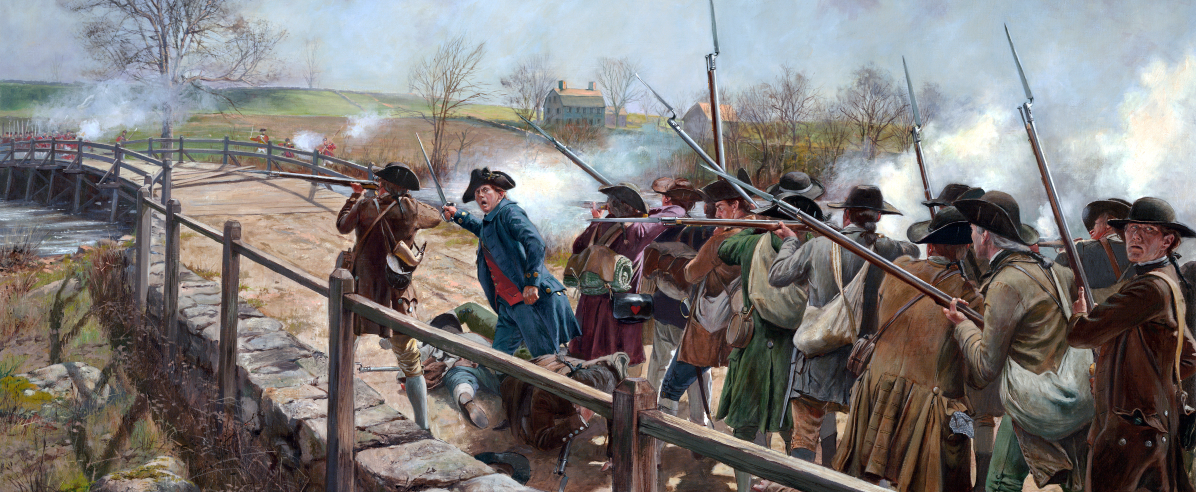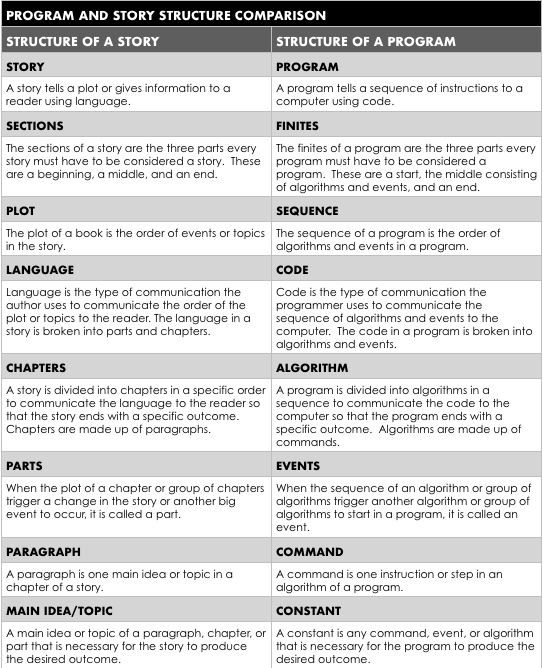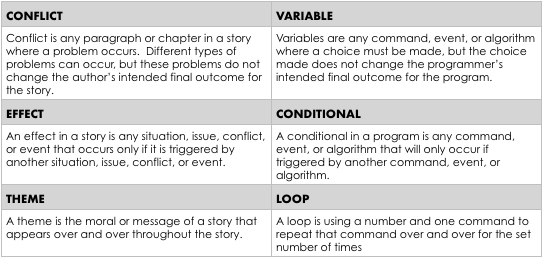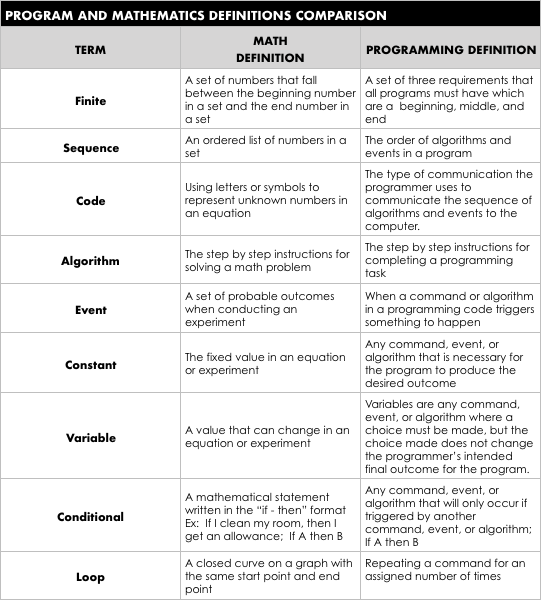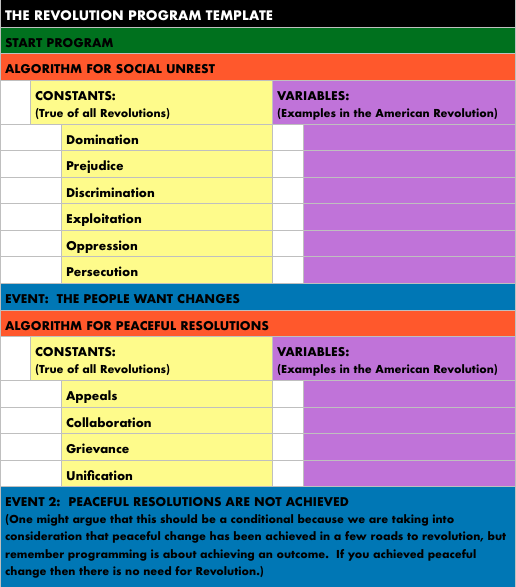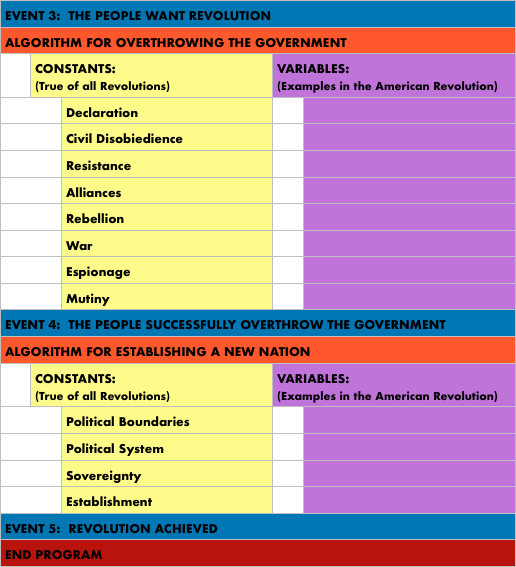5th Grade Cross-Curricular Unit
PROGRAMMING REVOLUTION
Unit Introduction
WELCOME TO A NEW WAY OF LOOKING AT THE AMERICAN REVOLUTION!
UNIT PURPOSE
Programming Revolution is a cross-curricular unit designed to incorporate 5th grade social studies, literacy, mathematics, science, and technology to achieve two major goals. By showing how all subjects come together in real life, students will better grasp the concepts and skills they are currently working on in their core classes and in computational thinking skills in STEM Lab. Cross-curricular units also help students develop critical thinking and problem solving skills that are applicable in grappling with new concepts and skills, as well as evaluating issues and situations in everyday life.
UNIT OVERVIEW
In the Programming Revolution Unit, students will use what they learned in STEM Lab about computer programming to create a computer program of the American Revolution. Students will use computational thinking skills including abstraction, algorithms, programming and development; develop computing analysis skills by manipulating data, analyzing systems, and participating in simulations; and will become innovative designers as they design a program for revolution.
UNIT BACKGROUND
5th Grade students have recently learned about computer programming. Students came to understand coding terms by comparing them to mathematical terms they have already learned. They analyzed coding structure by comparing it to story structure. These are reiterated in Lesson 1 of the Programming Revolution Unit. Below is a chart of the analogies and parallels in terms that were covered.
PROGRAM AND STORY STRUCTURE COMPARISON
PROGRAM AND MATHEMATICS DEFINITIONS COMPARISON
UNIT INTRODUCTION
In the course of reading about this unit, you will see underlined words. These words are links. Clicking on these links will open up a new tab that will take you to the Programming Revolution Glossary.
A Revolution occurs when the people of a nation overthrow their government and establish a new government. There have been many Revolutions in our world history and whether they were successful or unsuccessful, they have the same common factors that lead them to the idea of revolution and the same basic road in attempting revolution. If we were to tell the story of the American Revolutionary War as a computer program, we would start with these factors that are common in all revolutions and create a program for Revolution. We will start by establishing our finites. These are start, the algorithms and events that make up the middle, and the end. Then, we identify the constants in each algorithm. These are the things that are true of most revolutions. Finally, we identify the variables by charting examples of each algorithm’s constants that were true in the American Revolutionary War.
All students will have the same program template that includes start, the algorithms, events, and constants. Students could have different variables for each algorithm. This is because students may see different issues, situations, and events, as playing different parts in each algorithm. This is ok and actually encouraged, because remember, variables do not affect the program’s outcome.
The following chart is the Algorithm for Revolution Template the students will receive. They will use Google Sheets to design their programs.
THE REVOLUTION PROGRAM TEMPLATE
ALABAMA STATE STANDARDS ADDRESSED
ALABAMA 5th GRADE DIGITAL LITERACY AND COMPUTER SCIENCE STANDARDS
RECURRING STANDARDS
COLLABORATIVE RESEARCH
Standard 5: Locate and curate information from digital sources to answer research questions.
Standard 5: Locate and curate information from digital sources to answer research questions.
DIGITAL TOOLS
Standard 6: Produce, review, and revise authentic artifacts that include multimedia using appropriate digital tools.
Standard 6: Produce, review, and revise authentic artifacts that include multimedia using appropriate digital tools.
COMPUTATIONAL THINKER
ABSTRACTION
Standard 1:
Construct a complex system of numbers or letters to represent information.
Standard 1:
Construct a complex system of numbers or letters to represent information.
ALGORITHMS
Standard 2:
Create an algorithm to solve a problem while detecting and debugging logical errors within the algorithm.
Standard 3:
Create an algorithm that is defined by simple pseudocode.
Standard 4:
Create a simple pseudocode.
Standard 5:
Develop and recommend solutions to a given problem and explain the process to an audience.
Standard 2:
Create an algorithm to solve a problem while detecting and debugging logical errors within the algorithm.
Standard 3:
Create an algorithm that is defined by simple pseudocode.
Standard 4:
Create a simple pseudocode.
Standard 5:
Develop and recommend solutions to a given problem and explain the process to an audience.
PROGRAMMING AND DEVELOPMENT
Standard 6:
Create a working program in a block-based visual programming environment using arithmetic operators, conditionals, and repetition in programs.
Standard 7:
Identify variables.
Standard 8:
Demonstrate that programs require known starting values that may need to be updated appropriately during the execution of programs.
Standard 6:
Create a working program in a block-based visual programming environment using arithmetic operators, conditionals, and repetition in programs.
Standard 7:
Identify variables.
Standard 8:
Demonstrate that programs require known starting values that may need to be updated appropriately during the execution of programs.
GLOBAL COLLABORATOR
COMMUNICATION
Standard 17:
Publish organized information in different ways to make it more useful or relevant.
Standard 17:
Publish organized information in different ways to make it more useful or relevant.
COLLABORATIVE RESEARCH
Standard 19:
Conduct advanced keyword searches to produce valid, appropriate results and evaluate results for accuracy, relevance, and appropriateness.
Standard 19:
Conduct advanced keyword searches to produce valid, appropriate results and evaluate results for accuracy, relevance, and appropriateness.
COMPUTING ANALYST
DATA
Standard 21:
Manipulate data to answer a question using a variety of computing methods and tools to collect, organize, graph, analyze, and publish the resulting information.
Standard 21:
Manipulate data to answer a question using a variety of computing methods and tools to collect, organize, graph, analyze, and publish the resulting information.
SYSTEMS
Standard 23:
Identify the key components of a network.
Standard 23:
Identify the key components of a network.
MODELING AND SIMULATIONS
Standard 25:
Analyze the concepts, features, and behaviors illustrated by a simulation.
Standard 26:
Connect data from a simulation to real-life events.
Standard 25:
Analyze the concepts, features, and behaviors illustrated by a simulation.
Standard 26:
Connect data from a simulation to real-life events.
INNOVATIVE DESIGNER
DESIGN THINKING
Standard 28:
Develop, test, and refine prototypes as part of a cyclical design process to solve a complex problem.
Standard 28:
Develop, test, and refine prototypes as part of a cyclical design process to solve a complex problem.
ALABAMA 5th GRADE SOCIAL STUDIES STANDARDS
Standard 2: Identify causes and effects of early migration and settlement of North America.
Standard 3: Distinguish differences among major American Indian cultures in North America according to geographic region, natural resources, community organization, economy, and belief systems.
Standard 5: Explain the early colonization of North America and reasons for settlement in the Northern, Middle, and Southern colonies, including geographic features, landforms, and differences in climate among the colonies.
Standard 5.3: Describe the emerging colonial government.
Standard 7: Determine causes and events leading to the American Revolution, including the French and Indian War, the Stamp Act, the Intolerable Acts, the Boston Massacre, and the Boston Tea Party.
Standard 8: Identify major events of the American Revolution, including the battles of Lexington and Concord, Bunker Hill, Saratoga, and Yorktown.
Standard 8a: Describing principles contained in the Declaration of Independence.
Standard 8b: Explaining contributions of Thomas Jefferson, Samuel Adams, Paul Revere, Patrick Henry, George Washington, and supporters from other countries to the American Revolution.
Standard 8d: Explaining contributions of ordinary citizens, including African Americans and women, to the American Revolution.
Standard 8e: Describing efforts to mobilize support for the American Revolution by the Minutemen, Committees of Correspondence, First Continental Congress, Sons of Liberty, boycotts, and the Second Continental Congress
Standard 8f: Locating on a map major battle sites of the American Revolution, including the battles of Lexington and Concord, Bunker Hill, Saratoga, and Yorktown.
Standard 8g: Recognizing reasons for colonial victory in the American Revolution
Standard 8h: Explaining the effect of the Treaty of Paris of 1783 on the development of the United States.
Standard 9: Explain how inadequacies of the Articles of Confederation led to the creation and eventual ratification of the Constitution of the United States.
Standard 9a: Describing major ideas, concepts, and limitations of the Constitution of the United States, including duties and powers of the three branches of government.
Standard 9b: Identifying factions in favor of and opposed to ratification of the Constitution of the United States Example: Federalist and Anti-Federalist factions.
Standard 9c: Identifying main principles in the Bill of Rights.
Standard 9d: Analyzing the election of George Washington as President of the United States for its impact on the role of president in a republic.
ALABAMA 5th GRADE ENGLISH LANGUAGE ARTS STANDARDS
READING STANDARDS FOR LITERATURE
CRAFT AND STRUCTURE
Standard 5:
Explain how a series of chapters, scenes, or stanzas fits together to provide the overall structure of a particular story, drama, or poem. [RL.5.5]
Standard 5:
Explain how a series of chapters, scenes, or stanzas fits together to provide the overall structure of a particular story, drama, or poem. [RL.5.5]
READING STANDARDS FOR INFORMATIONAL TEXT
KEY IDEAS AND DETAILS
Standard 10:
Quote accurately from a text when explaining what the text says explicitly and when drawing inferences from the text. [RI.5.1]
Standard 10:
Quote accurately from a text when explaining what the text says explicitly and when drawing inferences from the text. [RI.5.1]
Standard 12:
Explain the relationships or interactions between two or more individuals, events, ideas, or concepts in a historical, scientific, or technical text based on specific information in the text. [RI.5.3]
Explain the relationships or interactions between two or more individuals, events, ideas, or concepts in a historical, scientific, or technical text based on specific information in the text. [RI.5.3]
CRAFT AND STRUCTURE
Standard 13:
Determine the meaning of general academic and domain-specific words and phrases in a text relevant to a Grade 5 topic or subject area. [RI.5.4]
Standard 13:
Determine the meaning of general academic and domain-specific words and phrases in a text relevant to a Grade 5 topic or subject area. [RI.5.4]
Standard 14:
Compare and contrast the overall structure (e.g., chronology, comparison, cause and effect,
problem and solution) of events, ideas, concepts, or information in two or more texts. [RI.5.5]
Compare and contrast the overall structure (e.g., chronology, comparison, cause and effect,
problem and solution) of events, ideas, concepts, or information in two or more texts. [RI.5.5]
WRITING STANDARDS
PRODUCTION AND DISTRIBUTION OF WRITING
Standard 27:
With some guidance and support from adults, use technology, including the Internet, to produce and publish writing as well as to interact and collaborate with others; demonstrate sufficient command of keyboarding skills to type a minimum of two pages in a single sitting. [W.5.6]
Standard 27:
With some guidance and support from adults, use technology, including the Internet, to produce and publish writing as well as to interact and collaborate with others; demonstrate sufficient command of keyboarding skills to type a minimum of two pages in a single sitting. [W.5.6]
RESEARCH TO BUILD AND PRESENT KNOWLEDGE
Standard 30:
Draw evidence from literary or informational texts to support analysis, reflection, and research. [W.5.9]
Standard 30:
Draw evidence from literary or informational texts to support analysis, reflection, and research. [W.5.9]
SPEAKING AND LISTENING STANDARDS
COMPREHENSION AND COLLABORATION
Standard 32:
Engage effectively in a range of collaborative discussions (one-on-one, in groups, and teacher led) with diverse partners on Grade 5 topics and texts, building on others’ ideas and expressing their own clearly.[SL.5.1]
Standard 32:
Engage effectively in a range of collaborative discussions (one-on-one, in groups, and teacher led) with diverse partners on Grade 5 topics and texts, building on others’ ideas and expressing their own clearly.[SL.5.1]
Standard 33:
Summarize a written text read aloud or information presented in diverse media and formats, including visually, quantitatively, and orally. [SL.5.2]
Summarize a written text read aloud or information presented in diverse media and formats, including visually, quantitatively, and orally. [SL.5.2]
PRESENTATION OF KNOWLEDGE AND IDEAS
Standard 35:
Report on a topic or text or present an opinion, sequencing ideas logically and using appropriate facts and relevant, descriptive details to support main ideas or themes; speak clearly at an understandable pace. [SL.5.4]
Standard 35:
Report on a topic or text or present an opinion, sequencing ideas logically and using appropriate facts and relevant, descriptive details to support main ideas or themes; speak clearly at an understandable pace. [SL.5.4]
Standard 36:
Include multimedia components (e.g., graphics, sound) and visual displays in presentations when appropriate to enhance the development of main ideas or themes. [SL.5.5]
Include multimedia components (e.g., graphics, sound) and visual displays in presentations when appropriate to enhance the development of main ideas or themes. [SL.5.5]
LANGUAGE STANDARDS
VOCABULARY ACQUISITION AND USE
Standard 41:
Determine or clarify the meaning of unknown and multiple-meaning words and phrases based on Grade 5 reading and content, choosing flexibly from a range of strategies. [L.5.4]
a. Use context (e.g., cause/effect relationships and comparisons in text) as a clue to the meaning of a
word or phrase. [L.5.4a]
b. Use common, grade-appropriate Greek and Latin affixes and roots as clues to the meaning of a word [L.5.4b]
c. Consult reference materials (e.g., dictionaries, glossaries, thesauruses), both print and digital, to find the
pronunciation and determine or clarify the precise meaning of key words and phrases. [L.5.4c]
Standard 41:
Determine or clarify the meaning of unknown and multiple-meaning words and phrases based on Grade 5 reading and content, choosing flexibly from a range of strategies. [L.5.4]
a. Use context (e.g., cause/effect relationships and comparisons in text) as a clue to the meaning of a
word or phrase. [L.5.4a]
b. Use common, grade-appropriate Greek and Latin affixes and roots as clues to the meaning of a word [L.5.4b]
c. Consult reference materials (e.g., dictionaries, glossaries, thesauruses), both print and digital, to find the
pronunciation and determine or clarify the precise meaning of key words and phrases. [L.5.4c]
ALABAMA 5th GRADE MATH STANDARDS
NUMBER OPERATIONS IN BASE TEN
UNDERSTAND THE PLACE VALUE SYSTEM
Standard 4:
Recognize that in a multi-digit number, a digit in one place represents 10 times as much as it represents in the place to its right and 1 /10 of what it represents in the place to its left. [5-NBT1]
Standard 4:
Recognize that in a multi-digit number, a digit in one place represents 10 times as much as it represents in the place to its right and 1 /10 of what it represents in the place to its left. [5-NBT1]
PERFORM OPERATIONS WITH MULTI-DIGIT WHOLE NUMBERS AND DECIMALS TO HUNDREDTHS
Standard 8:
Fluently multiply multi-digit whole numbers using the standard algorithm. [5-NBT5]
Standard 8:
Fluently multiply multi-digit whole numbers using the standard algorithm. [5-NBT5]
NUMBER AND OPERATIONS FRACTIONS
USE EQUIVALENT FRACTIONS AS A STRATEGY TO ADD AND SUBTRACT FRACTIONS
Standard 11:
Add and subtract fractions with unlike denominators (including mixed numbers) by replacing given fractions with equivalent fractions in such a way as to produce an equivalent sum or difference of fractions with like denominators. [5-NF1]
Standard 11:
Add and subtract fractions with unlike denominators (including mixed numbers) by replacing given fractions with equivalent fractions in such a way as to produce an equivalent sum or difference of fractions with like denominators. [5-NF1]
APPLY AND EXTEND PREVIOUS UNDERSTANDINGS OF MULTIPLICATION AND DIVISION TO MULTIPLY AND DIVIDE FRACTIONS
Standard 13:
Interpret a fraction as division of the numerator by the denominator ( a/b = a ÷ b). Solve word problems involving division of whole numbers leading to answers in the form of fractions or mixed numbers, e.g., by using visual fraction models or equations to represent the problem. [5-NF3]
Standard 13:
Interpret a fraction as division of the numerator by the denominator ( a/b = a ÷ b). Solve word problems involving division of whole numbers leading to answers in the form of fractions or mixed numbers, e.g., by using visual fraction models or equations to represent the problem. [5-NF3]
MEASUREMENT AND DATA
REPRESENT AND INTERPRET DATA
Standard 19:
Make a line plot to display a data set of measurements in fractions of a unit ( 1/2, 1/4, 1/8). Use operations on fractions for this grade to solve problems involving information presented in line plots. [5-MD2]
Standard 19:
Make a line plot to display a data set of measurements in fractions of a unit ( 1/2, 1/4, 1/8). Use operations on fractions for this grade to solve problems involving information presented in line plots. [5-MD2]
